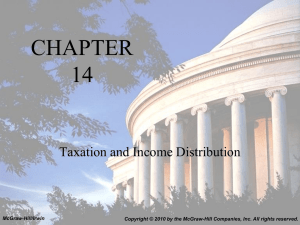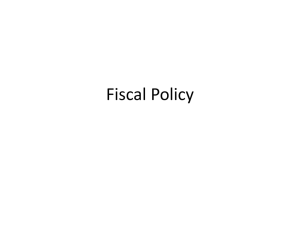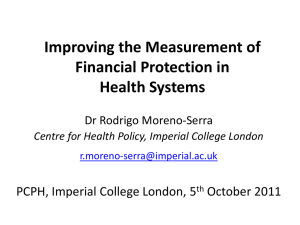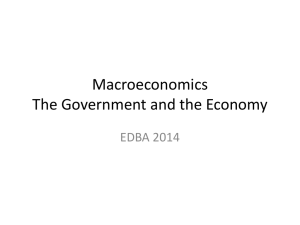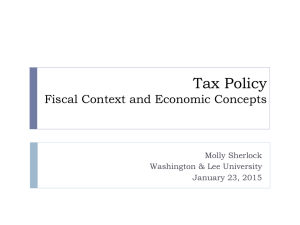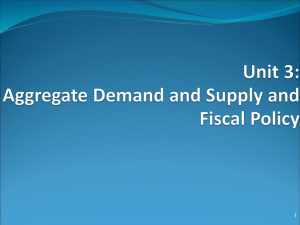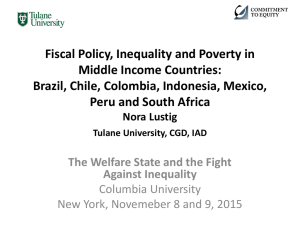Poverty and Shared Prosperity in Russia: Non
advertisement
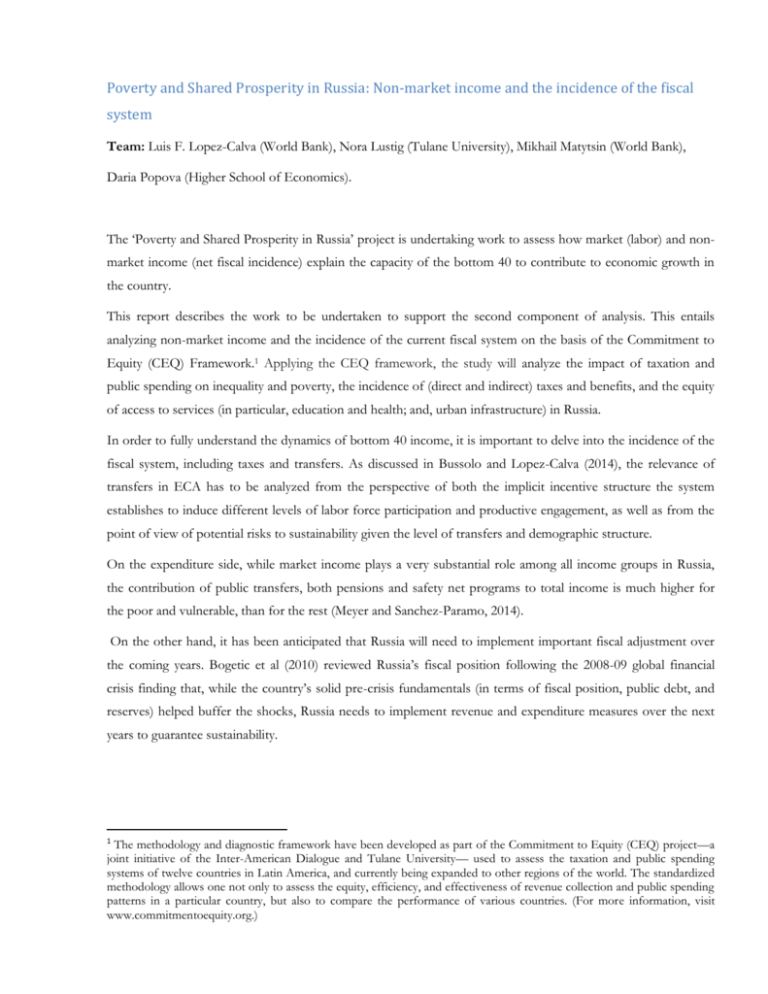
Poverty and Shared Prosperity in Russia: Non-market income and the incidence of the fiscal system Team: Luis F. Lopez-Calva (World Bank), Nora Lustig (Tulane University), Mikhail Matytsin (World Bank), Daria Popova (Higher School of Economics). The ‘Poverty and Shared Prosperity in Russia’ project is undertaking work to assess how market (labor) and nonmarket income (net fiscal incidence) explain the capacity of the bottom 40 to contribute to economic growth in the country. This report describes the work to be undertaken to support the second component of analysis. This entails analyzing non-market income and the incidence of the current fiscal system on the basis of the Commitment to Equity (CEQ) Framework.1 Applying the CEQ framework, the study will analyze the impact of taxation and public spending on inequality and poverty, the incidence of (direct and indirect) taxes and benefits, and the equity of access to services (in particular, education and health; and, urban infrastructure) in Russia. In order to fully understand the dynamics of bottom 40 income, it is important to delve into the incidence of the fiscal system, including taxes and transfers. As discussed in Bussolo and Lopez-Calva (2014), the relevance of transfers in ECA has to be analyzed from the perspective of both the implicit incentive structure the system establishes to induce different levels of labor force participation and productive engagement, as well as from the point of view of potential risks to sustainability given the level of transfers and demographic structure. On the expenditure side, while market income plays a very substantial role among all income groups in Russia, the contribution of public transfers, both pensions and safety net programs to total income is much higher for the poor and vulnerable, than for the rest (Meyer and Sanchez-Paramo, 2014). On the other hand, it has been anticipated that Russia will need to implement important fiscal adjustment over the coming years. Bogetic et al (2010) reviewed Russia’s fiscal position following the 2008-09 global financial crisis finding that, while the country’s solid pre-crisis fundamentals (in terms of fiscal position, public debt, and reserves) helped buffer the shocks, Russia needs to implement revenue and expenditure measures over the next years to guarantee sustainability. The methodology and diagnostic framework have been developed as part of the Commitment to Equity (CEQ) project—a joint initiative of the Inter-American Dialogue and Tulane University— used to assess the taxation and public spending systems of twelve countries in Latin America, and currently being expanded to other regions of the world. The standardized methodology allows one not only to assess the equity, efficiency, and effectiveness of revenue collection and public spending patterns in a particular country, but also to compare the performance of various countries. (For more information, visit www.commitmentoequity.org.) 1 To shed light on these issues, the second component of this project will analyze non-market income and the incidence of the current fiscal system on the basis of the Commitment to Equity (CEQ) Framework. 2 Applying the CEQ framework, the study will analyze the impact of taxation and public spending on inequality and poverty, the incidence of (direct and indirect) taxes and benefits, and the equity of access to services (in particular, education and health; and, urban infrastructure) in Russia. The CEQ Framework’s standardized method of tax and benefit incidence analysis and a comprehensive diagnostic set of questions will be used to assess the equity, efficiency, and effectiveness of revenue collection and public spending patterns in Russia. This will help answer the question of who bears the burden of taxation and who receives the benefits of public spending, and of how these burdens and benefits are distributed across socioeconomic groups, with emphasis on the bottom 40 group. The Incidence Analysis. It is important to point out from the outset that the methodology proposed relies on standard incidence analysis without behavioral, lifecycle or general equilibrium effects. In addition, the focus will be on average incidence rather than incidence at the margin. Finally, the analysis will exclude some important taxes/other revenues (corporate and international trade taxes, for example) and spending categories (infrastructure investments including urban services and rural roads that benefit the poor and the bottom 40, for example) that surely affect income distribution and poverty, but where methodologies are still to be fully developed. Great care must be placed in defining income concepts and specifying the method followed to estimate the incidence of every tax and benefit category. Based on Lustig and Higgins (2013), for each household in a household income and expenditure survey the method estimates market income and compares this measure of income with that of net market, disposable, post fiscal and final income. These measures generate different distributions from which one can estimate headcount poverty rates and other statistics that can be compared. This enables us to judge, at each stage, how equitably distributed household income is compared to a situation where there is no public interference. Defining Progressive and Regressive Tax and Spending Policies. To determine if a tax or transfer is progressive, concentration curves, concentration coefficients and the Kakwani (1977) index are used. Concentration curves are constructed similarly to Lorenz curves with the difference that the vertical axis measures the proportion of the tax (transfer) under analysis paid (received) by each quantile. Therefore, concentration curves for a transfer targeted to the poor, for example, can be above the diagonal; something which, by definition, could never happen with a Lorenz curve. Concentration coefficients are calculated in the same manner as the Gini; although it is worth noting that, in the cases in which the concentration coefficient is above the diagonal, the difference The methodology and diagnostic framework have been developed as part of the Commitment to Equity (CEQ) project—a joint initiative of the Inter-American Dialogue and Tulane University— used to assess the taxation and public spending systems of twelve countries in Latin America, and currently being expanded to other regions of the world. The standardized methodology allows one not only to assess the equity, efficiency, and effectiveness of revenue collection and public spending patterns in a particular country, but also to compare the performance of various countries. (For more information, visit www.commitmentoequity.org.) 2 between the triangle of perfect equality and the area under the curve is negative, which cannot occur with the Gini for the income distribution by definition. The data used to generate concentration curves and coefficients is derived from incidence analyses. Information on direct and indirect taxes, transfers (in cash and in kind) and subsidies, however, cannot always be obtained directly from the available household survey. When the data is readily obtained, we call this the Direct Identification Method. When the direct method is not feasible, we will use inference, simulation or imputation methods. These methods are detailed, on the basis of the Commitment to Equity (CEQ) Framework in Lustig and Higgins (2013). The information and results will allow policymakers and stakeholders to learn about whether the current fiscal structure reinforces or offsets the patterns determined in the markets. This, along with the analysis of the labor income dynamics, will allow us to establish lessons and potential areas of intervention. Bogetic, Zeljko, Karlis Smits, Nina Budina and Sweder van Wijnbergen. 2010. "Long-term fiscal risks and sustainability in an oil-rich country : the case of Russia." Policy Research Working Paper Series 5240, The World Bank. Bussolo, Maurizio and Luis F. Lopez-Calva. 2014. “Shared Prosperity: Paving the Way in Europe and Central Asia.” The World Bank. Kakwani, N.C. 1977. “Measurement of tax progressivity: an international comparison.” The Economic Journal 87, 71-80. Lustig, Nora, and Sean Higgins. 2013. Commitment to Equity Assessment (CEQ): Estimating the Incidence of Social Spending, Subsidies and Taxes. Handbook, CEQ Working Paper No. 1, July 2011; revised September 2013. New Orleans, LA. Meyer, Moritz, and Carolina Sánchez-Páramo. 2014. “Economic Mobility and the Emergence of the Middle Class in Russia.” mimeograph, The World Bank Group.


